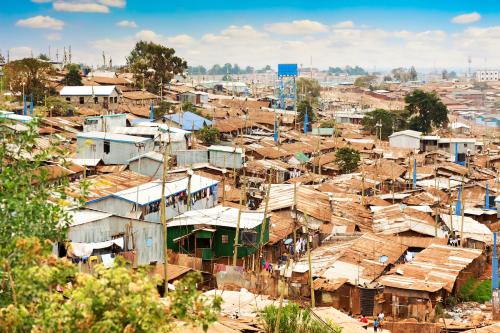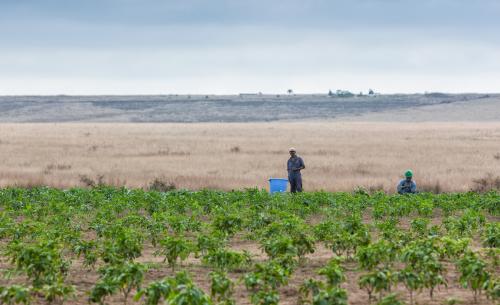This viewpoint is part of Foresight Africa 2024.
For Africa, the energy transition is therefore not merely about reaching net zero by a target date, but about securing a decent existence and sustainable livelihoods for the fastest growing population on earth.
Africa is faced with not one, but two existential challenges. There is climate change itself, warming up the continent faster than any other region of the world. And despite emitting the least to global emissions, Africa remains the most vulnerable to the worst of its ravages. Then there is the added challenge of energy poverty and lack of access, and its implications for the survival of Africa’s 1.4 billion people, 580 million of whom have no access to energy. More than 150 million Africans have access to unreliable energy and nearly 1 billion have no access to clean cooking, leading to 600,000 avoidable deaths per year.
For Africa, the energy transition is therefore not merely about reaching net zero by a target date, but about securing a decent existence and sustainable livelihoods for the fastest growing population on earth. However, were Africa to grow to middle to high income status on the same carbon intensive pathway that wealthier countries have gone, she will add at least 9.4 gigatons of CO2 emissions annually until 2050,1 making global net zero ambitions impossible to achieve. But this conundrum disguises a real opportunity: An opportunity for Africa to grow to middle income status and beyond while solving humanity’s biggest existential threat, climate change. The opportunity lies in climate positive growth. African countries can decarbonize the world, halt, and eventually undo climate damage—and generate inclusive economic growth, jobs, and livelihoods. With the world’s largest untapped renewable energy potential, youngest and fastest growing workforce, and 30% of the world’s critical minerals, Africa is uniquely positioned to lead on green global manufacturing and supply chains and remove carbon from the air. The abundance and low seasonality of Africa’s renewable energy position it to reliably provide considerably cheaper renewable base load to continuously power industrial production. Providing the same renewable base load from Kenya would cost half as much as from Spain, one of Europe’s best renewable power locations, and 20% less from Nigeria.2 In fact, by aggressively deploying its renewable energy resources, Africa can provide energy to all Africans—600 million of whom currently lack access to energy and 150 million of whom have unreliable access to energy—at a 30% lower cost and with over 90% lower emissions per kWh, compared to the current stated policy.
Furthermore, significant cost efficiencies can be achieved by establishing green value chains to process critical raw materials on the continent. A BloombergNEF study on the production of battery precursors found that manufacturing in the lithium and cobalt rich Democratic Republic of the Congo (DRC) is three times cheaper than in the U.S., Poland, and China. In addition, manufacturing in DRC would expand value chain opportunities to other African countries, as the process would require manganese from Zambia, Tanzania, Gabon, and South Africa to contribute to its production capacity. Using green hydrogen to process raw materials such as iron ore (nearly 80 tons produced annually) into green steel locally would also lower global emission rates by 110 million tons a year and supply global car manufacturers.3
In fact, African countries are already inserting themselves firmly in value chains by imposing restrictions on the export of critical raw minerals. Excluding North Africa, over 42% of African countries4 now have these restrictions, including Zimbabwe (with Africa’s largest lithium reserves), Namibia, and Nigeria. Mining companies are establishing local processing plants in response, creating more job opportunities for Africa’s young and growing workforce. It is critical that these establishments are accompanied by local laws ensuring the transfer of relevant skills and protection of worker rights.
Realizing such opportunities and powering local value chains with renewable energy could transform Africa from a source of raw materials to a bustling green industrial hub. For example, if Africa processed the bauxite mines (24% of global bauxite production) to aluminium with renewable energy before exporting it, we could save 335 million tons of CO2 emissions per year (1 percent of global emissions), create 280,000 jobs, and generate $37 billion of additional revenue for the continent.
In September 2023, the African Union adopted the Nairobi Declaration at the inaugural Africa Climate Summit. The Declaration states:
Africa possesses both the potential and the ambition to be a vital component of the global solution to climate change. […] Our continent has the fundamentals to spearhead a climate compatible pathway as a thriving, cost-competitive industrial hub with the capacity to support other regions in achieving their net zero ambitions.
The Declaration then commits to pursue a climate positive development path, listing a series of concrete commitments and focus areas. Structurally, there are four key elements for implementation of Africa’s climate positive growth ambition. Two of these are primarily the responsibility of African countries, while the other two elements require global collaboration. The Nairobi Declaration includes these as African commitments: African countries must focus economic development plans on climate positive growth and develop and implement supporting legislation and regulation.
The two requirements for global collaboration are appropriate and sufficient finance and investment and fair and equitable market access. Africa brings ambition and commitment, underpinned by action and achievement. Yet it cannot do this alone. Collective global action is required to mobilize the necessary capital to invest. The second area of global collaboration is the need for market access to ensure that production happens where it makes the most climate and economic sense. This has implications for trade and industrial policy—both in African countries to stimulate investment, and globally, to allow Africa to meet global demand efficiently.
What is different about the climate positive growth paradigm is its scale and scope. It is about rethinking the global allocation of economic activities and investment, building on Africa’s intrinsic value as one of the most cost-competitive locations for climate action.
With Africa’s climate competitiveness, we can provide solutions to achieve net zero emissions globally, grow our economies, and create jobs.
-
Footnotes
- Climate Action Platform Africa (CAP-A).2023. “Towards sustainable global prosperity – Climate Positive Growth”. Nairobi, Kenya: Climate Action Platform Africa.
- Ibid.
- Ibid.
- Nosmot Gbadamosi. 2022. “Zimbabwe’s ‘White Gold’”. Foreign Policy.






Commentary
Africa: Navigating the energy transition
June 26, 2024